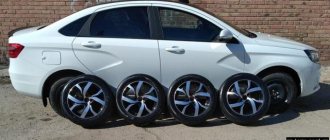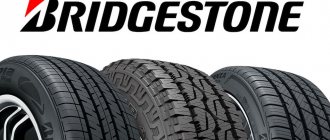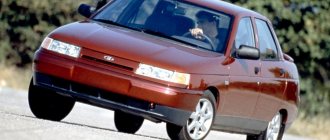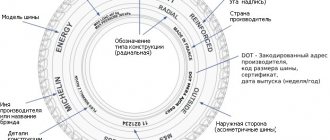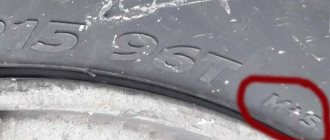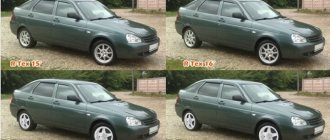Winter tire tests 2017-2018 (Behind the Wheel, Autoreview, ADAC, Auto Bild)
Tests of winter and summer tires, which are carried out every year by a number of qualified organizations, will help you avoid getting lost in the abundance of names, marks and brands. This includes:
ADAC Club
ADAC is a serious organization that has represented the interests of German motorists for more than a century. The largest car club in Europe checks car brands for quality and safety, and also regularly tests tires. It is difficult for tire manufacturers to achieve high ratings from ADAC - their severe tests, carried out with true German thoroughness, can leave neither the bottom nor the tire of the tire. The usual results are “satisfactory”, and rarely does a tire receive a “good” verdict.
The oldest Russian magazine dedicated to car enthusiasts and their iron horses. He regularly tests popular and not so popular tires on the post-Soviet market in hot and cold weather, and also conducts interesting studies such as “How temperature affects the length of a car’s braking distance.”
Car enthusiasts from more than 35 countries around the world read licensed editions of the German magazine Auto Bild. The magazine presents not only motor sports and industry news, but also comparative tests, test drives and, of course, tire testing in various interesting places - for example, in a small Finnish village beyond the Arctic Circle.
The popular Russian (and formerly Soviet) publication "Autoreview" regularly conducts comparative tests of cars at the test site, crash tests using European methods with its own independent rating, and also tests automotive products, ranging from fuel to child car seats. Of course, tires are also on the list.
Which tires are better - Cordiant or Nokian Tires?
In the October 2021 PartReview, Nokian Tires were overall better than Cordiant.
- Nokian Tires received a PR score of 77 out of 100, and Cordiant managed to score 74 points.
- Nokian Tires took 12th place in the ranking of the best manufacturers, and Cordiant took 14th place.
- The average review score for Nokian Tires (4) is higher than for Cordiant (3.8).
- Nokian Tires tires have better property ratings than Cordiant:
- Handling - owners believe that Nokian Tires has this property better than Cordiant.
- Wear resistance - car enthusiasts claim that Nokian Tires is no different from Cordiant in this property.
- Noise - from the reviews it is clear that this property is preferable for Nokian Tires than for Cordiant.
Rating of winter studded tires 2017-2018
Since fresh tire tests are carried out during the peak season, we based the rating on tests of R14, R15, R16, R17 tires carried out last winter
. When allocating places on the list, we also took into account: the popularity of the model in Russia, ratings, reviews and the cost of tires on the Yandex Market service.
Despite the differences in conditions, tests of the best winter studded tires 2017-2018. carried out using a similar method:
- acceleration and braking dynamics are tested on ice, snow, wet and dry asphalt;
- the time it takes to travel a certain distance on different types of coverage is taken into account;
- an assessment is made of the car's handling level, its smoothness and how noisy the tires are.
10. Gislaved Nord Frost 200
Average cost - 5,570 rubles.
The rating of winter studded tires for 2017-2018 opens with a new model from the Swedish company Gislaved. The main highlight of the 200th model is the asymmetrical tread pattern and the new ultra-light (less than 1 gram) stud in the shape of a three-rayed star. In general, the tires are quiet, soft, with good directional stability, and grip well on any surface - although on fresh snow and ice it may require adjustments to your driving style. On a slightly icy highway, you should not accelerate more than 100 km on such tires, otherwise the car will drive.
Average price: RUB 5,982.
The very name of the tire says that its developers (Russian company Cordiant) paid special attention to the behavior of the tire on snow. The tread pattern is directional, the center of which is a closed rib, which in theory should significantly reduce the likelihood of hydroplaning in the snow. (It’s interesting, by the way, that this same pattern almost exactly copies the tread of the third place in the rating.) The result is good tires at a budget price that ride really well in the snow. True, asphalt is not as good for her as snow.
Average price - 8,600 rubles.
A clear improvement over the ICE 01, both in terms of directional stability and reduced noise levels on asphalt. It is difficult to expect the response speed of more expensive tires from mid-price segment tires, but the Dunlop SP Winter ICE 02 delivers 100% of its value. Advantages: high cross-country ability, very strong sidewall, excellent studs, paddles in slush. True, it does not feel very good on asphalt, and is noticeably noisy, and at speeds above 90 km/h it causes increased fuel consumption.
Cost, on average - 6,670 rubles.
Good city tires with the ability to feel comfortable in not too deep snow. It rides well both on asphalt and in dense snow, the noise is within normal limits. It is worth noting that it is best to use this tire in central Russia, where temperatures rarely exceed -15 degrees. But for Siberians with deep snow and prolonged frosts, it is better to think about a more hardy option.
Average cost - 2,410 rubles.
The Nordman series from Nokian is a more budget version of the famous Hakkapeliitta. Soft, comfortable, low-noise tires at a reasonable price, which feel good on both dry asphalt and snow. On wet asphalt, based on reviews, it is better not to accelerate over 100 km. A good option for city residents in the “home-work-dacha” mode. Due to the softness of the rubber, it is difficult to drive out of the ruts, and you should be careful with curbs, branches and other sharp objects. But overall an excellent option in terms of price/quality.
You can buy, on average, for 4,860 rubles.
While the previous top 10 model was mainly intended for city driving, Continental's IceContact 2 is at its best off-road. Feels great at low temperatures, both on snow and on crust or ice, and is able to take its owner anywhere. The big advantage is the many studs (there are 196 of them). You can't hear any noise from these tires.
But on wet, frozen or snowy asphalt you need to take extra care. Also, the “behavior” of the tires on slushy snow has not received the best reviews, where it begins to wander.
Offered, on average, for 10,260 rubles.
Although the V8 is a newer model in the Hakkapeliitta tire line, it is slightly inferior in popularity to its predecessor. One of the main reasons is the very soft sidewall, as a result of which you will have to carefully select the wheels and, despite the excellent cross-country ability, carefully select the riding locations. Otherwise, hernias and cuts. But this tire is very predictable, has a large number of studs (190 pieces) and goes well on ice and packed snow.
Sold, on average, for 7,100 rubles.
It differs from the eighth model in fewer spikes (by 30%), but its hexagonal anchor spikes are longer and heavier. They use a technology called "bear claw" that prevents the stud from tilting, thereby improving grip. Silent, reliable, albeit expensive tires, which, despite the generation, enjoy a high reputation among car enthusiasts. It feels good both on snow and on ice and asphalt, while being durable and strong. However, like the eighth version, Hakkapeliitta 7 has a very soft sidewall and this is felt when turning the steering wheel sharply.
Average price - 9,080 rubles.
And here comes the new generation of the famous line. The fruit of four years of efforts by the Finnish company's developers is said to exceed the characteristics of the G8 by 5-10%. The biggest highlight of the new model is two types of studs (although overall there are slightly fewer of them than its predecessor), which should improve lateral grip on snowy or icy roads. And changes in the rubber composition will help the tire feel better at low temperatures. So far, according to preliminary tests, the tires promise to be excellent, but the chickens are being counted in the fall - when mass sales of the “nine” begin.
Pirelli Ice Zero
On average, it costs 15,550 rubles.
Paradoxically, it turned out that the Italians understand the issue of producing winter studded tires better than the inhabitants of snowy Scandinavia. One of the “highlights” of the model is the original double carbide stud insert, which provides the tire with excellent behavior on ice.
Other advantages: high cross-country ability, good acceleration and braking on snow and ice, high directional stability. And endurance - there is a chance to bring the tires to retirement with a full set of studs. Excellent, almost universal tires for winter conditions, feeling good both on asphalt and outside the city. True, its noise level is quite high. And the price is steep.
Which winter tires are best to choose in the end?
So which winter tires are best? The 2021 rating includes both “urban” types of tires and tires designed for more severe weather conditions. For frequent off-road driving, Pirelli Ice Zero, Continental IceContact 2 or Dunlop SP Winter ICE 02 are perfect. For quiet city driving, it is better to choose Bridgestone Ice Cruiser 7000, Nokian Nordman 5 or Nokian Hakkapeliitta 8. Otherwise, when choosing tires, you should first consider temperature conditions, and the surface on which you will have to drive.
Tires from the Russian manufacturer Cordiant are often compared in terms of performance characteristics with tires from the Finnish manufacturer Nokian. Such a comparison is quite appropriate because most tire models have the same characteristics and components used in the rubber mixture for tire production. They can also be compared with unspoken indicators, such as safety, comfort of use, grip on the road surface and other characteristics.
So which tires are the best and which models should you choose in different seasons? Let's look at these questions in more detail.
Cordiant tires
ATTENTION! A completely simple way to reduce fuel consumption has been found! Don't believe me? An auto mechanic with 15 years of experience also didn’t believe it until he tried it. And now he saves 35,000 rubles a year on gasoline!
Russian Cordiant tires have some advantages that most other tire models from other European manufacturers do not have. These advantages, first of all, include the ability to use tires in harsh winter times, their safety margin is incredibly high, and the design features of the tires and the composition of the rubber compound allow these tires not to lose air pressure during sudden temperature changes. For the use of such tires in Russian conditions, this is a very important advantage, since most European modifications of car tires have such an unpleasant property - the pressure in the tires drops sharply with a sharp jump in air temperature.
It should also be noted that Cordiant tires have excellent road grip. A large number of winter tires are studded, which gives such excellent grip even on completely icy road surfaces, even when driving on such a road at very high speeds. The braking properties of these tires are also well developed - the braking distance even on slippery surfaces is quite short.
Susceptibility to temperature changes, grip and braking qualities - these properties can be considered the most important advantage of using Russian tires. This is not to say that these tires no longer have positive qualities, but all other properties are less well developed.
Which tires are more popular - Nokian Tires or Cordiant?
In October 2021, on PartReview, Nokian Tires tires were generally more popular than Cordiant.
In terms of votes, Nokian Tires tires surpassed Cordiant:
- Nokian Tires had a ratio of positive votes (667) to negative votes (197) of 470 votes.
- Cordiant had a ratio of positive votes (478) to negative votes (165) of 313 votes.
In terms of the number of reviews, Nokian Tires tires surpassed Cordiant:
- There are 268 reviews written on Nokian Tires tires: 191 positive, 43 neutral, 34 negative.
- There are 200 reviews written on Cordiant tires: 136 positive, 33 neutral, 31 negative.
Nokian tires
Finnish Nokian tires are very familiar to both Russian drivers and everyone else around the world. Everyone knows very well that these tires have excellent performance characteristics and are famous for their safety and reliability of use. Let's take a closer look at all the benefits that drivers of cars equipped with these Finnish-made tires receive.
Let's start with the fact that all car tires produced by Nokian have excellent road grip, even in Russian road conditions. It must be said that this is facilitated by a large number of factors - these are the design features of these car tires, and the optimized tread pattern for each Finnish-made tire model, and the composition of the rubber mixture that is used for the production of Nokian tire models.
The optimized design of the projector has extended grooves in almost all models, and this allows water masses to be removed from the contact patch in a fairly short period of time. This property prevents the formation of a water wedge when moving on a wet road surface, which, in principle, indicates the virtual absence of drift from a straight path during high-speed movement.
It should also be noted that all Nokian tires have a very high degree of safety and reliability. Tires are made from a large number of synthetic materials, which may indicate that the materials are not environmentally friendly, but in reality this is not the case - the composition of the rubber mixture is still dominated by the presence of natural rubber.
What to choose: Cordiant or Yokohama
Yokohama is a Japanese company that has been a leader in the tire market for many years. Rubber of this brand is superior to Cordiant in a number of operational and technical aspects. It is also known that the Russian manufacturer borrows technology for making “shoes” for wheels from its opponent and copies the tread pattern on some winter models.
Pros and cons of Cordiant winter tires
Kordiant winter tires meet all international standards of quality and ride comfort. Products are manufactured using modern equipment and tested using computer simulation.
Motorists are well aware of the affordable price and adaptation of Cordiant tires to the specific road conditions of Russia. The tires last for 3-4 seasons of operation, they retain traction even in severe frosts. Among the disadvantages, buyers note the noise of studded tires and insufficient traction on ice with Velcro.
Pros and cons of winter tires "Yokohama"
The famous Japanese company produces 6 types of winter tires:
- Ice Guard IG55;
- Ice Guard IG 604;
- Ice Guard IG50+;
- Ice Guard SUV G075;
- Drive V905;
- Drive WY01.
The range includes 1 studded and 5 friction types of tires. The main disadvantages of winter tires from the Japanese company are weak cords on some models, unpredictable behavior in ruts, and overpriced.
The tread of the Yokohama Ice Guard IG55 studded winter tires is covered with special high-strength studs with a shaped body and transversely oriented “dumbbell” inserts. The directional tread pattern is both an advantage and a disadvantage of such wheels. Its structure provides maximum traction, but drivers note that when driving in wet snow, the wide slots in the pattern quickly become clogged.
The best Cordiant tire models
The best modifications of car tires in the Cordiant model range can be considered Comfort PS 400 and Winter Drive, according to the opinions and assessments of independent experts. The first model is intended for use in the summer season, but many Russian drivers often use it in winter, since the safety margin and excellent road grip allow this to be done.
The only drawback of this trick is the loss of tire pressure; after all, this is a summer model, which is not entirely intended for use in the winter season. In general, road grip, excellent rolling resistance, and excellent properties for removing water masses from the contact patch are quite developed in this model and are in no way inferior to many leading European-made models.
As for the Winter Drive model, this winter modification also has an exceptionally high level of safety of use, and also creates excellent reliability when driving on poor road surfaces in winter. This tire model is equipped with studs, which allows you to significantly reduce the braking distance during any braking. It is also worth noting the high acceleration properties that are achieved thanks to the optimized tread pattern. It is because of it that the tires fit tightly to the road surface, allowing cars to quickly accelerate and brake sharply.
Nokian or Cordiant
Cordiant has the best model - Snow Cross. Its cost is approximately the same as that of Hakkapeliitta 8, so the comparison conditions are close. Cordiant improves vehicle dynamics and prevents slipping on snow and ice. Handling in such conditions is excellent.
The directional stability of the tires is at a decent level. However, on asphalt surfaces, the braking distance increases, and at high speed, fuel consumption increases significantly. Among other things, the tread pattern causes additional noise.
Hakapelita 8 does not have such disadvantages. There is only one - poor resistance to rutting. However, compared to the disadvantages, Cordiant is only a minor drawback. As you can understand, Nokian is a noticeable leader in comparison with Cordiant and is suitable for any operating conditions.
The best Nokian tire models
The most leading models of car tires from the Finnish manufacturer Nokian are modifications of Hakka Green and Nordman SX. The first model is summer, and it has a huge number of advantages. These tires have virtually no disadvantages - each quality is highly developed, which allows drivers to feel comfortable and safe in any car on the road in any condition in various weather conditions.
It is especially worth highlighting the grip on the road surface, which allows you to maintain a straight trajectory when driving on not the best roads. This model also has excellent sound insulation - the sound of wheels touching during high-speed driving is virtually inaudible. Also, the properties of water repellency and rolling resistance are at a fairly high level.
As for the Nordman SX model, all the same qualities can be noted here. The only thing worth noting here additionally is better grip on any quality road surface. These tires have an excellent, optimized rubber compound composition - it includes absorbent gels, natural rubber and silica. All this together gives these tires excellent performance in all conditions of use.
Design characteristics
When looking for information about which tires are better than Hankook or Nokian, it is worth considering that Hankook uses a wide range of design features to increase the uniqueness and originality of the tires:
- Each tire is designed with a control philosophy that ensures the perfect interaction between car, driver and road.
- Sustainability is a key feature.
- A wide range of tires suitable for almost any passenger car and any road conditions.
- Hankook tires are always designed with the environment in mind.
Final comparison of Cordiant and Nokian tires
If we compare the best models of Cordiant and Nokian tires, it becomes clear that Russian-made tires still do not reach the level of performance that exists in the production of Finnish tires. In all respects, Nokian tires are superior to their Russian counterparts, except for one component - if we consider the conditions of use in Russia, then, of course, Cordiant tires win here, since they were created for use specifically on Russian roads.
However, they have also found use on European roads. In all other respects, Cordiant tires are noticeably inferior to Finnish products - in terms of road grip quality, braking properties, speed characteristics and many other features.
Summary
As a result, we can say the following - even if we consider the model ranges of both car tire manufacturers in full and try to compare them with each other, then such a comparison is inappropriate and meaningless - car tires from the Finnish manufacturer Nokian have a clear advantage here. In the Finnish manufacturer's model range there are no models that have either low performance qualities or at least average ones.
This suggests that the Finnish manufacturer has really worked hard on the technologies for producing its own products, which ultimately brought Nokian tires to a qualitatively new high level. The Russian manufacturer just needs to work further in this direction. This is not to say that everything is so bad with Russian Cordiant tires - far from it, many characteristics are very well developed. But still, this development does not occur at such a qualitatively high level as with Finnish-made tires.
Winter tires from 12 manufacturers were tested in two stages. This was done by the Krasnoyarsk Central Medical Center and the Institute of Chemistry and Chemical Technology of the SB RAS.
At the first stage, the institute’s laboratory assistants took samples of tires for the experiment and began testing them for quality. They checked for wear, frost resistance, elasticity and the permissible limit of sub-zero temperatures.
Each tire was sampled three times and tested in three ways. First, they cut off a piece of rubber and passed it through a machine with a “reel” until it began to wear out - this is how the samples were tested for strength. Then another piece was dipped into a container with nitrogen and alcohol. The third sample from above was pressed with a press - this was how the level of frost resistance and elasticity was determined.
As experts explain, 12 samples are the tires that are most popular in Russia and Krasnoyarsk in particular. Samples were selected according to 3 sizes:
- 205/55R16
- used on KIA Ceed, Ford Focus, Honda Accord, Honda Civic, Huyndai Elantra, Mazda 5, Opel Zafira, Renault Laguna, Seat Toledo, Skoda SuperB, Subary Legacy, Toyota Auris, Toyota Avensis, Toyota Corolla, Toyota Corolla Verso, VW Passat, Renault Megane, etc.; - 225/65R17
- used on Toyota Rav4, Vanguard, Honda CR-V, Suzuki Grand Vitara, Honda CR-V, Dodge Caravan, Grand Caravan, Journey, Mazda CX-5, etc.; - in the light truck segment, the most popular size 185/75R16 °C
- used on GAZ 3302 Gazelle, Sobol and their modifications.
“Given the fact that in the winter of 2021, temperatures below minus 55°C were recorded in the Krasnoyarsk Territory, of particular interest is the study of brands that initially position themselves as “tyres for harsh winter conditions,” such as Nokian and Cordiant,” says the study.
Attention was also paid to the price of tires. The most informative indicators about quality are indicators of frost resistance and temperature limit of brittleness. The third indicator, abrasion, largely depends on the testing conditions - in the laboratory or in the fields.
The operating temperature of the tire is of significant importance - the operating temperature of winter tires is below 0°C, the composition of the rubber mixture is designed in such a way that the performance characteristics give maximum performance at negative temperatures (including mileage). It is for this reason that the use of winter tires in the summer leads to a sharp decrease in the service life of the tire, while the tire does not provide adequate adhesion to the road surface (the braking distance increases), the principles in the CSM explain.
The results of the monitoring showed, the researchers believe, that all tires are suitable for use in harsh Krasnoyarsk conditions according to their characteristics. However, they have a slight difference in temperature indicators, and the prices differ significantly.
Among the sizes 225/65 R17 (sample 5–8), the undisputed leader was sample No. 7 - Cordiant Snow Cross. It showed the best results in terms of temperature and at the same time turned out to be affordable in price, and “therefore has the best price-quality ratio.” Samples No. 5, 6, 8 (Yokohama IceGuard IG55, Dunlop Grandtrek Ice 02, Toyo Observe G-3 Ice) have good temperature performance, but a higher price.
Among 185/75 R16 °C (sample 9–12), the best temperature coefficients were shown by sample No. 11 of the Nokian Nordman C brand at the highest price. Samples No. 9 (Kama-Euro-520), No. 12 (Codriant Business CW-2) also have good temperature characteristics at a lower price. Sample No. 10 of the Matador MPS 500 Sibir Ice Van brand, being in the same price segment, is slightly inferior in temperature to samples No. 9, 12.
The last option we considered was size 205/55R16. Samples No. 1, 2, 3 have almost identical temperature indicators (minus 65–66°C), while sample No. 1 (Cordiant Snow Cross) has the lowest price and, accordingly, is the most interesting in terms of price-quality ratio. For sample No. 4 (Hankook Winter I*pike RS w419), the temperature limit of fragility was minus 54°C, and at not the lowest cost, the sample showed the lowest result, the experts summed up.
Today, on the eve of the winter season, I would like to offer your attention a small review of both new products and already familiar models of winter shoes for your car. The review is based on an analysis of expert findings and our opinions as consumers. Let our selection be a guide for you that will help you choose the right tires for the frosty season. So, which winter tires are better:
What features do Cordiant tires have?
Cordiant tires provide good traction, which ensures good vehicle handling. These tires are manufactured using the most modern European technologies. Also, they are quite affordable.
The profile pattern on the tire ensures stability on the road surface, as well as predictability of the vehicle on the road in any season and in any weather conditions. Cordiant tires provide short braking distances and reduced fuel consumption.
Cordiant tires are available in various models, both for winter and summer.
Kumho, hankook, and goodyear tires are also popular.
Winter tires from 12 manufacturers were tested in two stages. This was done by the Krasnoyarsk Central Medical Center and the Institute of Chemistry and Chemical Technology of the SB RAS.
At the first stage, the institute’s laboratory assistants took samples of tires for the experiment and began testing them for quality. They checked for wear, frost resistance, elasticity and the permissible limit of sub-zero temperatures.
Each tire was sampled three times and tested in three ways. First, they cut off a piece of rubber and passed it through a machine with a “reel” until it began to wear out - this is how the samples were tested for strength. Then another piece was dipped into a container with nitrogen and alcohol. The third sample from above was pressed with a press - this was how the level of frost resistance and elasticity was determined.
As experts explain, 12 samples are the tires that are most popular in Russia and Krasnoyarsk in particular. Samples were selected according to 3 sizes:
- 205/55R16
- used on KIA Ceed, Ford Focus, Honda Accord, Honda Civic, Huyndai Elantra, Mazda 5, Opel Zafira, Renault Laguna, Seat Toledo, Skoda SuperB, Subary Legacy, Toyota Auris, Toyota Avensis, Toyota Corolla, Toyota Corolla Verso, VW Passat, Renault Megane, etc.; - 225/65R17
- used on Toyota Rav4, Vanguard, Honda CR-V, Suzuki Grand Vitara, Honda CR-V, Dodge Caravan, Grand Caravan, Journey, Mazda CX-5, etc.; - in the light truck segment, the most popular size 185/75R16 °C
- used on GAZ 3302 Gazelle, Sobol and their modifications.
“Given the fact that in the winter of 2021, temperatures below minus 55°C were recorded in the Krasnoyarsk Territory, of particular interest is the study of brands that initially position themselves as “tyres for harsh winter conditions,” such as Nokian and Cordiant,” says the study.
Attention was also paid to the price of tires. The most informative indicators about quality are indicators of frost resistance and temperature limit of brittleness. The third indicator, abrasion, largely depends on the testing conditions - in the laboratory or in the fields.
The operating temperature of the tire is of significant importance - the operating temperature of winter tires is below 0°C, the composition of the rubber mixture is designed in such a way that the performance characteristics give maximum performance at negative temperatures (including mileage). It is for this reason that the use of winter tires in the summer leads to a sharp decrease in the service life of the tire, while the tire does not provide adequate adhesion to the road surface (the braking distance increases), the principles in the CSM explain.
The results of the monitoring showed, the researchers believe, that all tires are suitable for use in harsh Krasnoyarsk conditions according to their characteristics. However, they have a slight difference in temperature indicators, and the prices differ significantly.
Among the sizes 225/65 R17 (sample 5–8), the undisputed leader was sample No. 7 - Cordiant Snow Cross. It showed the best results in terms of temperature and at the same time turned out to be affordable in price, and “therefore has the best price-quality ratio.” Samples No. 5, 6, 8 (Yokohama IceGuard IG55, Dunlop Grandtrek Ice 02, Toyo Observe G-3 Ice) have good temperature performance, but a higher price.
Among 185/75 R16 °C (sample 9–12), the best temperature coefficients were shown by sample No. 11 of the Nokian Nordman C brand at the highest price. Samples No. 9 (Kama-Euro-520), No. 12 (Codriant Business CW-2) also have good temperature characteristics at a lower price. Sample No. 10 of the Matador MPS 500 Sibir Ice Van brand, being in the same price segment, is slightly inferior in temperature to samples No. 9, 12.
The last option we considered was size 205/55R16. Samples No. 1, 2, 3 have almost identical temperature indicators (minus 65–66°C), while sample No. 1 (Cordiant Snow Cross) has the lowest price and, accordingly, is the most interesting in terms of price-quality ratio. For sample No. 4 (Hankook Winter I*pike RS w419), the temperature limit of fragility was minus 54°C, and at not the lowest cost, the sample showed the lowest result, the experts summed up.
205/55 R16
Budget "winter"
The popular “sixteenth” tire size comes from popular brands. In this comparative test, we collected and evaluated the qualities of ten friction tires costing from 100 to 200 rubles. The cheapest of the selected tires were produced in Russia (Cordiant and Viatti) and Belarus (Belshina’s native Artmotion). But the most expensive was the Japanese Dunlop: from 200 rubles per wheel. Let's see how much more effective and safe this imported product turns out to be. Also included in the test were studded tires – Nitto Therma Spike. We did not stud them (by the way, studding one wheel will cost about 40 rubles) and decided to check how “unarmed” tires, which are designed to be used without studs, would perform.
We also remind you that during comparative tests, the characteristics of winter tires are primarily assessed, which are responsible for safe behavior on roads covered with snow or ice, as well as on wet and dry asphalt. Simply put, we evaluate the level of grip provided by the tires.
The winter part of the tests was carried out at a polar training ground on ice and snow at a temperature of -10...-8°C. The spring part of the tests took place at a temperature of +5...+7°C.
The test program for Scandinavian winter tires includes four tests on icy surfaces. Acceleration and braking on ice are the most important for any driver. In the test with braking from a speed of 25 km/h, five tires performed excellently, stopping the car in 12-13 meters. The leaders are Nokian and Cordiant. Among the outsiders, four tires of the Dunlop, Kumho and Nitto brands stopped the car almost 1.5 meters later. Belshina's result is the lagging behind, 16 meters. The same pattern of results was noted in the acceleration time test on ice.
A similar ranking of test participants was noted in the lateral grip test on ice. In this test, the car moved around an ice circle for a time. The better a particular tire provided stability on a bend, the faster the car completed a lap. The best results were shown by Nokian and Viatti tires, and the pilot noted the clear behavior and predictable handling on both of these tires. Then, with a lag of about 1.5 seconds, the test car arrived on Sava, Cordiant, Gislaved and Hankook tires. The pilot also noted that on these tires the cars begin to slide outward early, and on Hankook tires, the “grip” that seems good at first glance is replaced by a rather sharp drift into sliding. The last four tires were noted for their low lap speed, due to weak lateral grip on ice, and rather deep drifts.
A more complex and multifaceted test of tires on ice is driving on an icy track at speed. Cordiant and Nokian tires showed good and similar results, which also give the car clear and predictable driving behavior. Dunlop tires also give the car a very harmonious character, but their grip on ice is generally worse. “Belshina” showed an average time and was generally remembered for its rather predictable handling. The same cannot be said about Sava and especially Nitto tires, which behave nervously on ice: on them the car suddenly and deeply breaks into skids or drifts.
This time, among budget tires, Hankook tires showed an exemplary result. The worst result is for the “unarmed” Nitto. When accelerating on snow, the spread of results increased to 15%. Six tires showed very close results with a difference of literally 5%. The outsiders were Nitto, Belshina and Sava.
But in a more dynamic test - checking handling on a snowy track - Sava tires performed exemplary. They provide good lateral grip and give the car easy handling. Viatti and Nitto tires, as well as Nokian, showed quite decent results. Less confidently, the test car rushed along the track on Hankook and Gislaved tires.
The “spring” tests of winter tires on asphalt included braking on wet and dry asphalt, as well as handling on a wet track. As often happens, in the asphalt program tires perform well that lost on ice and snow. In braking on wet asphalt, Sava tires showed the best results. The second result is for Belshina. The longest braking distance - with an extra four meters - was shown on Dunlop and Kumho tires.
Sava tires also led in handling on wet asphalt; Gislaved tires showed very close results. “Belshina” held on well, showing the 4th result. The slipperiest tires on wet asphalt were Kumho, Dunlop, Cordiant and especially Nitto.
Rolling resistance
We assessed the ease of rolling on a special stand with a metal drum. For studded tires, the studs had to be removed for this test. The rolling resistance coefficient is expressed in kg/t (or N/kN). A factor of 7 kg/t means that if a tire is weighed down by one tonne, a force of 70 N must be constantly applied to it to prevent it from losing speed due to rolling resistance. The lowest rolling resistance coefficient is found in winter tires Nokian, Hankook and Gislaved. The highest are at Cordiant and Belshin.


